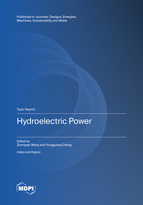Topic Menu
► Topic MenuTopic Editors


Hydroelectric Power

A printed edition is available here.
Topic Information
Dear Colleagues,
Hydropower is an inexhaustible, renewable, and clean energy. Hydropower technology is a science and technology that converts water energy into electrical energy, including technical and economic issues on engineering construction and production operation. In the modern power system, the proportion of hydropower generation is growing bigger and bigger, with an increasing number of scholars studying hydropower generation technology. Hydropower technology involves many fields, such as power plant site selection, hydrological forecasting, and hydropower dispatching, and it requires expertise in geology, machinery, and power systems. The purpose of this Special Issue is to attract the latest progress in the field of global hydropower planning and operation management and to integrate scholars in various fields, such as hydrology, electromechanical, and electric power to discuss the current challenges faced by hydropower. We aim to provide a venue for discussion around the development of clean energy technology in the world. The topics of interest for publication include but are not limited to:
- Hydrological processes;
- Hydropower dispatching;
- Hydroelectric power plant site selection;
- Hydrogenerators;
- Electricity market and hydropower station management.
Prof. Dr. Zhengwei Wang
Prof. Dr. Yongguang Cheng
Topic Editors
Keywords
- hydroelectric power
- geological engineering
- hydraulic machinery
- renewable energy
Participating Journals
| Journal Name | Impact Factor | CiteScore | Launched Year | First Decision (median) | APC |
|---|---|---|---|---|---|

Designs
|
- | 4.8 | 2017 | 18.3 Days | CHF 1600 |

Energies
|
3.2 | 7.3 | 2008 | 16.2 Days | CHF 2600 |

Machines
|
2.5 | 4.7 | 2013 | 16.9 Days | CHF 2400 |

Sustainability
|
3.3 | 7.7 | 2009 | 19.3 Days | CHF 2400 |

Water
|
3.0 | 6.0 | 2009 | 19.1 Days | CHF 2600 |

Preprints.org is a multidisciplinary platform offering a preprint service designed to facilitate the early sharing of your research. It supports and empowers your research journey from the very beginning.
MDPI Topics is collaborating with Preprints.org and has established a direct connection between MDPI journals and the platform. Authors are encouraged to take advantage of this opportunity by posting their preprints at Preprints.org prior to publication:
- Share your research immediately: disseminate your ideas prior to publication and establish priority for your work.
- Safeguard your intellectual contribution: Protect your ideas with a time-stamped preprint that serves as proof of your research timeline.
- Boost visibility and impact: Increase the reach and influence of your research by making it accessible to a global audience.
- Gain early feedback: Receive valuable input and insights from peers before submitting to a journal.
- Ensure broad indexing: Web of Science (Preprint Citation Index), Google Scholar, Crossref, SHARE, PrePubMed, Scilit and Europe PMC.

